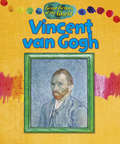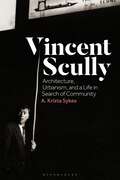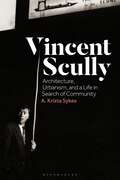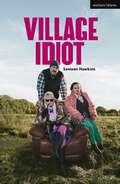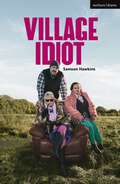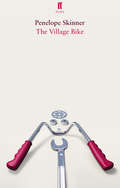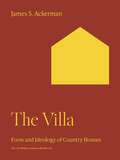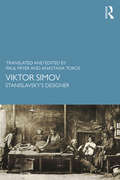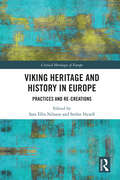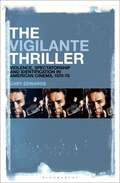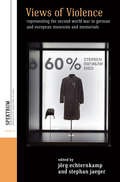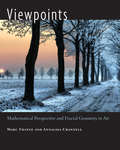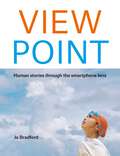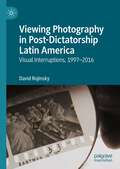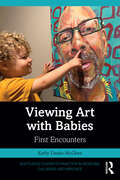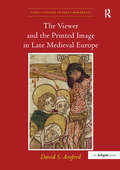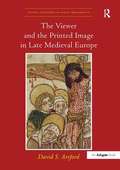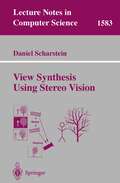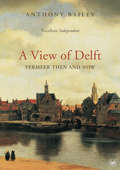- Table View
- List View
Vincent van Gogh (Great Artists of the World #3)
by Alix WoodGreat Artists introduces young readers to some of the world's great artists. The books feature easy-to-read text and some of the most famous examples of each artist's work, as well as photographs of places and people of importance.
Vincent Scully: Architecture, Urbanism, and a Life in Search of Community
by Dr A. Krista SykesThe renowned architectural historian and critic, beloved Yale professor, and outspoken public activist Vincent Scully (1920–2017) emerged in the 1950s as a guiding voice in American architecture. This intellectual biography of Scully's life and career traces the formative moments in his thinking, mapping his relationships with a constellation of architects, artists, and cultural personalities of the past one hundred years. Scully charted an unlikely course from postwar modernism to postmodernism and New Urbanism, overturning outdated beliefs and changing the face of the built environment as he went. A teacher for more than 60 years and a figure of immense importance in the field, he was central to an expansive network of associations, from Frank Lloyd Wright, Louis Kahn, and Robert Venturi to Robert Stern, Harold Bloom, and Norman Mailer. Scully's extensive body of work, with its range spanning centuries and civilizations, coalesced around the core beliefs that architecture shapes and is shaped by society, and that the best architecture responds, above all else, to the human need for community and connection. This timely appraisal provides a platform for reassessing the legacy of these values as well as how we write and think about architecture in the twenty-first century.
Vincent Scully: Architecture, Urbanism, and a Life in Search of Community
by Dr A. Krista SykesThe renowned architectural historian and critic, beloved Yale professor, and outspoken public activist Vincent Scully (1920–2017) emerged in the 1950s as a guiding voice in American architecture. This intellectual biography of Scully's life and career traces the formative moments in his thinking, mapping his relationships with a constellation of architects, artists, and cultural personalities of the past one hundred years. Scully charted an unlikely course from postwar modernism to postmodernism and New Urbanism, overturning outdated beliefs and changing the face of the built environment as he went. A teacher for more than 60 years and a figure of immense importance in the field, he was central to an expansive network of associations, from Frank Lloyd Wright, Louis Kahn, and Robert Venturi to Robert Stern, Harold Bloom, and Norman Mailer. Scully's extensive body of work, with its range spanning centuries and civilizations, coalesced around the core beliefs that architecture shapes and is shaped by society, and that the best architecture responds, above all else, to the human need for community and connection. This timely appraisal provides a platform for reassessing the legacy of these values as well as how we write and think about architecture in the twenty-first century.
Village Idiot (Modern Plays)
by Samson HawkinsIf I were an animal there would be legislation to protect my home, but because I'm just a bloody human they can do whatever the f**k they like.Welcome to the village of Syresham; it's not quite the Cotswolds. Townies have decided they want a lie in, so they're building a new high-speed railway. Issue is, it's going right through Barbara Honeybone's house, and she 'ent having none of it. Barbara's grandson Peter works for the townies and it's his job to convince the village that having a two-tonne bullet hurtling through their cabbage patches will actually be for the best. Then there's Harry, Barbara's younger grandson, he 'ent that bothered about trains, he's only got eyes for Debbie Mahoney. But the only thing Barbara hates more than townies is the Mahoneys.Originally commissioned by Nottingham Playhouse, Village Idiot by Samson Hawkins is an audacious comedy, where family feuds kick off around a country fair that all you townies are invited to.This edition was published to coincide with the world premiere of the Theatre Royal Stratford East, Nottingham Playhouse and Ramps On The Moon co-production in March 2023.
Village Idiot (Modern Plays)
by Samson HawkinsIf I were an animal there would be legislation to protect my home, but because I'm just a bloody human they can do whatever the f**k they like.Welcome to the village of Syresham; it's not quite the Cotswolds. Townies have decided they want a lie in, so they're building a new high-speed railway. Issue is, it's going right through Barbara Honeybone's house, and she 'ent having none of it. Barbara's grandson Peter works for the townies and it's his job to convince the village that having a two-tonne bullet hurtling through their cabbage patches will actually be for the best. Then there's Harry, Barbara's younger grandson, he 'ent that bothered about trains, he's only got eyes for Debbie Mahoney. But the only thing Barbara hates more than townies is the Mahoneys.Originally commissioned by Nottingham Playhouse, Village Idiot by Samson Hawkins is an audacious comedy, where family feuds kick off around a country fair that all you townies are invited to.This edition was published to coincide with the world premiere of the Theatre Royal Stratford East, Nottingham Playhouse and Ramps On The Moon co-production in March 2023.
The Village Bike
by Penelope SkinnerIsn't she gorgeous? Hardly been ridden. She's been in the garage just gathering dust.Becky's pregnant and frustrated. But her husband is more interested in the baby manual than her new underwear, so she turns to the porn stash under the bed. As the summer heats up, a brief encounter sends her speeding downhill towards reckless abandon.A provocative and darkly comic look at fantasy and romance, The Village Bike by Penelope Skinner premiered at the Royal Court Theatre, London, in June 2011.Penelope Skinner won the George Devine Award for Most Promising Playwright 2011.
The Villa: Form and Ideology of Country Houses (The A. W. Mellon Lectures in the Fine Arts #34)
by James S. AckermanA classic account of the villa—from ancient Rome to the twentieth century—by “the preeminent American scholar of Italian Renaissance architecture” (Architect’s Newspaper)In The Villa, James Ackerman explores villa building in the West from ancient Rome to twentieth-century France and America. In this wide-ranging book, he illuminates such topics as the early villas of the Medici, the rise of the Palladian villa in England, and the modern villas of Frank Lloyd Wright and Le Corbusier. Ackerman uses the phenomenon of the “country place” as a focus for examining the relationships between urban and rural life, between building and the natural environment, and between architectural design and social, cultural, economic, and political forces. “The villa,” he reminds us, “accommodates a fantasy which is impervious to reality.” As city dwellers idealized country life, the villa, unlike the farmhouse, became associated with pleasure and asserted its modernity and status as a product of the architect’s imagination.
Viktor Simov: Stanislavsky’s Designer
by Paul Fryer Anastasia TorosViktor Simov is the first English-language biography of Konstantin Stanislavsky’s principal scenic designer at the Moscow Art Theatre from the company’s formation in 1898. His ground-breaking work included the designs for the premieres of Anton Chekhov’s major stage plays, and his approach to theatre design still influences contemporary scenography. Translated from the original Russian text written by author, editor, and literary critic Yuri Ivanovich Nekhoroshev, the book provides a revealing insight into the staging and technical practices of one of the world’s most influential theatre companies. Supported by 60 illustrations representing the full range of Simov’s designs, this volume provides a historical account of Simov’s career and a vivid description and critical assessment of his work. The book traces the artist’s development from his early years as a painter to his later experiments in early silent film design, including his work for the classic Russian science fiction film Aelita, Queen of Mars (1924). Written for theatre scholars and students of Scenic Design and Drama courses, Viktor Simov: Stanislavsky’s designer re-establishes Simov as one of the most influential theatre designers of the 20th century.
Viktor Simov: Stanislavsky’s Designer
by Paul Fryer Anastasia TorosViktor Simov is the first English-language biography of Konstantin Stanislavsky’s principal scenic designer at the Moscow Art Theatre from the company’s formation in 1898. His ground-breaking work included the designs for the premieres of Anton Chekhov’s major stage plays, and his approach to theatre design still influences contemporary scenography. Translated from the original Russian text written by author, editor, and literary critic Yuri Ivanovich Nekhoroshev, the book provides a revealing insight into the staging and technical practices of one of the world’s most influential theatre companies. Supported by 60 illustrations representing the full range of Simov’s designs, this volume provides a historical account of Simov’s career and a vivid description and critical assessment of his work. The book traces the artist’s development from his early years as a painter to his later experiments in early silent film design, including his work for the classic Russian science fiction film Aelita, Queen of Mars (1924). Written for theatre scholars and students of Scenic Design and Drama courses, Viktor Simov: Stanislavsky’s designer re-establishes Simov as one of the most influential theatre designers of the 20th century.
Viking Heritage and History in Europe: Practices and Re-creations (Critical Heritages of Europe)
by Sara Ellis Nilsson Stefan NyzellViking Heritage and History in Europe presents new research and perspectives on the use of the Vikings in public history, especially in relation to museums, re-creation, and re-enactment in a European context.Taking a critical heritage approach, the volume provides new insights into the re-creation of history, imagining the past, interpretation, ambivalence of authenticity, authority of History, remembrance and memory, medievalism, and public history. Highlighting the complexity of the field of public history today, the fourteen chapters all engage with questions of historical authenticity and authority. The volume also critically examines the public’s reception, engagement with, and interpretation of the Viking Age and the concepts of who these individuals were. Each chapter illuminates an aspect of these themes in relation to museums, leisure activities, politics, tourism, re-enactment, and popular culture – all from the vantage point of Viking cultural heritage.Viking Heritage and History in Europe is one of the first volumes to examine the use and role of the Vikings within the field of public history, both past and present. The book will be of interest to those engaged in the study of heritage, public history, history, the Vikings, vikingism, medievalism, and media history.
Viking Heritage and History in Europe: Practices and Re-creations (Critical Heritages of Europe)
Viking Heritage and History in Europe presents new research and perspectives on the use of the Vikings in public history, especially in relation to museums, re-creation, and re-enactment in a European context.Taking a critical heritage approach, the volume provides new insights into the re-creation of history, imagining the past, interpretation, ambivalence of authenticity, authority of History, remembrance and memory, medievalism, and public history. Highlighting the complexity of the field of public history today, the fourteen chapters all engage with questions of historical authenticity and authority. The volume also critically examines the public’s reception, engagement with, and interpretation of the Viking Age and the concepts of who these individuals were. Each chapter illuminates an aspect of these themes in relation to museums, leisure activities, politics, tourism, re-enactment, and popular culture – all from the vantage point of Viking cultural heritage.Viking Heritage and History in Europe is one of the first volumes to examine the use and role of the Vikings within the field of public history, both past and present. The book will be of interest to those engaged in the study of heritage, public history, history, the Vikings, vikingism, medievalism, and media history.
The Vigilante Thriller: Violence, Spectatorship and Identification in American Cinema, 1970-76
by Cary EdwardsThis is a detailed examination of vigilantism in 1970s American film, from its humble niche beginnings as a response to relaxing censorship laws to its growth into a unique subgenre of its own. Cary Edwards explores the contextual factors leading to this new cycle of films ranging from Joe (1970) and The French Connection (1971) to Dirty Harry (1971) and Taxi Driver (1976), all of which have been challenged by contemporary critics for their gratuitous, copycat-inspiring violence. Yet close analysis of these films reveals a recurring focus on the emerging moral panic of the 1970s, a problematisation of Law and Order's role in contemporary society, and an increasing awareness of the impossibility of American myths of identity.
The Vigilante Thriller: Violence, Spectatorship and Identification in American Cinema, 1970-76
by Cary EdwardsThis is a detailed examination of vigilantism in 1970s American film, from its humble niche beginnings as a response to relaxing censorship laws to its growth into a unique subgenre of its own. Cary Edwards explores the contextual factors leading to this new cycle of films ranging from Joe (1970) and The French Connection (1971) to Dirty Harry (1971) and Taxi Driver (1976), all of which have been challenged by contemporary critics for their gratuitous, copycat-inspiring violence. Yet close analysis of these films reveals a recurring focus on the emerging moral panic of the 1970s, a problematisation of Law and Order's role in contemporary society, and an increasing awareness of the impossibility of American myths of identity.
Views of Violence: Representing the Second World War in German and European Museums and Memorials (Spektrum: Publications of the German Studies Association #19)
by Jörg Echternkamp Stephan JaegerTwenty-first-century views of historical violence have been immeasurably influenced by cultural representations of the Second World War. Within Europe, one of the key sites for such representation has been the vast array of museums and memorials that reflect contemporary ideas of war, the roles of soldiers and civilians, and the self-perception of those who remember. This volume takes a historical perspective on museums covering the Second World War and explores how these institutions came to define political contexts and cultures of public memory in Germany, across Europe, and throughout the world.
Views of Violence: Representing the Second World War in German and European Museums and Memorials (Spektrum: Publications of the German Studies Association #19)
by Jörg Echternkamp and Stephan JaegerTwenty-first-century views of historical violence have been immeasurably influenced by cultural representations of the Second World War. Within Europe, one of the key sites for such representation has been the vast array of museums and memorials that reflect contemporary ideas of war, the roles of soldiers and civilians, and the self-perception of those who remember. This volume takes a historical perspective on museums covering the Second World War and explores how these institutions came to define political contexts and cultures of public memory in Germany, across Europe, and throughout the world.
Viewpoints: Mathematical Perspective and Fractal Geometry in Art
by Marc Frantz Annalisa CrannellAn undergraduate textbook devoted exclusively to relationships between mathematics and art, Viewpoints is ideally suited for math-for-liberal-arts courses and mathematics courses for fine arts majors. The textbook contains a wide variety of classroom-tested activities and problems, a series of essays by contemporary artists written especially for the book, and a plethora of pedagogical and learning opportunities for instructors and students. Viewpoints focuses on two mathematical areas: perspective related to drawing man-made forms and fractal geometry related to drawing natural forms. Investigating facets of the three-dimensional world in order to understand mathematical concepts behind the art, the textbook explores art topics including comic, anamorphic, and classical art, as well as photography, while presenting such mathematical ideas as proportion, ratio, self-similarity, exponents, and logarithms. Straightforward problems and rewarding solutions empower students to make accurate, sophisticated drawings. Personal essays and short biographies by contemporary artists are interspersed between chapters and are accompanied by images of their work. These fine artists--who include mathematicians and scientists--examine how mathematics influences their art. Accessible to students of all levels, Viewpoints encourages experimentation and collaboration, and captures the essence of artistic and mathematical creation and discovery. Classroom-tested activities and problem solving Accessible problems that move beyond regular art school curriculum Multiple solutions of varying difficulty and applicability Appropriate for students of all mathematics and art levels Original and exclusive essays by contemporary artists Forthcoming: Instructor's manual (available only to teachers)
Viewpoints: Mathematical Perspective and Fractal Geometry in Art
by Marc Frantz Annalisa CrannellAn undergraduate textbook devoted exclusively to relationships between mathematics and art, Viewpoints is ideally suited for math-for-liberal-arts courses and mathematics courses for fine arts majors. The textbook contains a wide variety of classroom-tested activities and problems, a series of essays by contemporary artists written especially for the book, and a plethora of pedagogical and learning opportunities for instructors and students. Viewpoints focuses on two mathematical areas: perspective related to drawing man-made forms and fractal geometry related to drawing natural forms. Investigating facets of the three-dimensional world in order to understand mathematical concepts behind the art, the textbook explores art topics including comic, anamorphic, and classical art, as well as photography, while presenting such mathematical ideas as proportion, ratio, self-similarity, exponents, and logarithms. Straightforward problems and rewarding solutions empower students to make accurate, sophisticated drawings. Personal essays and short biographies by contemporary artists are interspersed between chapters and are accompanied by images of their work. These fine artists--who include mathematicians and scientists--examine how mathematics influences their art. Accessible to students of all levels, Viewpoints encourages experimentation and collaboration, and captures the essence of artistic and mathematical creation and discovery. Classroom-tested activities and problem solving Accessible problems that move beyond regular art school curriculum Multiple solutions of varying difficulty and applicability Appropriate for students of all mathematics and art levels Original and exclusive essays by contemporary artists Forthcoming: Instructor's manual (available only to teachers)
ViewPoint: Human stories through the smartphone lens
by Jo BradfordInternational in scope and full of beautiful and impactful imagery that highlights the immediacy of the genre, View/Point is a book of human experience stories as told through the medium of phone photography. Featuring more than 50 contributors from every corner of the globe, interviewed by the author about their lives and their photographic art, this book offers a definitive take on both the power of the still image to tell a story and the joy of personal expression that phone photography offers.
Viewing Photography in Post-Dictatorship Latin America: Visual Interruptions, 1997-2016
by David RojinskyThis book examines the archival aesthetic of mourning and memory developed by Latin American artists and photographers between 1997-2016. Particular attention is paid to how photographs of the assassinated or disappeared political dissident of the 1970s and 1980s, as found in family albums and in official archives, were not only re-imagined as conduits for private mourning, but also became allegories of social trauma and the struggle against socio-political amnesia. Memorials, art installations, photo-essays, street projections, and documentary films are all considered as media for the reframing of these archival images from the era of the Cold War dictatorships in Argentina, Chile, Guatemala, and Uruguay. While the turn of the millennium was supposedly marked by “the end of history” and, with the advent of digital technologies, by “the end of photography,” these works served to interrupt and hence, belie the dominant narrative on both counts. Indeed, the book's overarching contention is that the viewer’s affective identification with distant suffering when engaging these artworks is equally interrupted: instead, the viewer is invited to apprehend memorial images as emblems of national and international histories of ideological struggle.
Viewing Art with Babies: First Encounters (Routledge Guides to Practice in Museums, Galleries and Heritage)
by Kathy Danko-McGheeViewing Art with Babies demonstrates how to facilitate quality art viewing experiences with babies from as young as 2 months old. Such experiences can help to nurture early literacy and receptive language skills, sensory stimulation, and early brain development. Based on the author’s research with babies in New Zealand, Australia, Romania, England, and the U.S., the book provides the reader with information about early brain, vision, sensory and language development, and the aesthetic preferences of babies. Danko-McGhee provides details about the type of art that babies like, how to display art in the learning environment, and how to interact with a baby when viewing art. Case studies of international museums, national museums, and community agencies that have had success with engaging babies in art viewing experiences have been included in the book as a way of demonstrating how theory and research can be successfully put into practice. Viewing Art with Babies details practical ways through which museum practitioners, early childhood and community educators, and parents can provide artviewing experiences in the museum, early childhood classroom or even their own home. It will be of interest to practitioners and parents around the world, and those engaged in the study of museum education.
Viewing Art with Babies: First Encounters (Routledge Guides to Practice in Museums, Galleries and Heritage)
by Kathy Danko-McGheeViewing Art with Babies demonstrates how to facilitate quality art viewing experiences with babies from as young as 2 months old. Such experiences can help to nurture early literacy and receptive language skills, sensory stimulation, and early brain development. Based on the author’s research with babies in New Zealand, Australia, Romania, England, and the U.S., the book provides the reader with information about early brain, vision, sensory and language development, and the aesthetic preferences of babies. Danko-McGhee provides details about the type of art that babies like, how to display art in the learning environment, and how to interact with a baby when viewing art. Case studies of international museums, national museums, and community agencies that have had success with engaging babies in art viewing experiences have been included in the book as a way of demonstrating how theory and research can be successfully put into practice. Viewing Art with Babies details practical ways through which museum practitioners, early childhood and community educators, and parents can provide artviewing experiences in the museum, early childhood classroom or even their own home. It will be of interest to practitioners and parents around the world, and those engaged in the study of museum education.
The Viewer and the Printed Image in Late Medieval Europe (PDF): Visual Culture in Early Modernity
by David S. ArefordStructured around in-depth and interconnected case studies and driven by a methodology of material, contextual, and iconographic analysis, this book argues that early European single-sheet prints, in both the north and south, are best understood as highly accessible objects shaped and framed by individual viewers. Author David Areford offers a synthetic historical narrative of early prints that stresses their unusual material nature, as well as their accessibility to a variety of viewers, both lay and monastic. This volume represents a shift in the study of the early printed image, one that mirrors the widespread movement in art history away from issues of production, style, and the artist toward issues of reception, function, and the viewer. Areford's approach is intensely grounded in the object, especially the unacknowledged material complexity of the print as a portable, malleable, and accessible image that depended on a response that was not only visual but often physical, emotional, and psychological. Recognizing that early prints were not primarily designed for aesthetic appreciation, the author analyzes how their meanings stemmed from specific functions involving private devotion, protection, indulgences, the cult of saints, pilgrimage, exorcism, the art of memory, and anti-Semitic propaganda. Although the medium's first century was clearly transitional and experimental, Areford explores how its potential to impact viewers in new ways?both positive and negative?was quickly realized.
The Viewer and the Printed Image in Late Medieval Europe (PDF): Visual Culture in Early Modernity
by David S. ArefordStructured around in-depth and interconnected case studies and driven by a methodology of material, contextual, and iconographic analysis, this book argues that early European single-sheet prints, in both the north and south, are best understood as highly accessible objects shaped and framed by individual viewers. Author David Areford offers a synthetic historical narrative of early prints that stresses their unusual material nature, as well as their accessibility to a variety of viewers, both lay and monastic. This volume represents a shift in the study of the early printed image, one that mirrors the widespread movement in art history away from issues of production, style, and the artist toward issues of reception, function, and the viewer. Areford's approach is intensely grounded in the object, especially the unacknowledged material complexity of the print as a portable, malleable, and accessible image that depended on a response that was not only visual but often physical, emotional, and psychological. Recognizing that early prints were not primarily designed for aesthetic appreciation, the author analyzes how their meanings stemmed from specific functions involving private devotion, protection, indulgences, the cult of saints, pilgrimage, exorcism, the art of memory, and anti-Semitic propaganda. Although the medium's first century was clearly transitional and experimental, Areford explores how its potential to impact viewers in new ways?both positive and negative?was quickly realized.
View Synthesis Using Stereo Vision (Lecture Notes in Computer Science #1583)
by Daniel ScharsteinImage-based rendering, as an area of overlap between computer graphics and computer vision, uses computer vision techniques to aid in sythesizing new views of scenes. Image-based rendering methods are having a substantial impact on the field of computer graphics, and also play an important role in the related field of multimedia systems, for applications such as teleconferencing, remote instruction and surgery, virtual reality and entertainment.The book develops a novel way of formalizing the view synthesis problem under the full perspective model, yielding a clean, linear warping equation. It shows new techniques for dealing with visibility issues such as partial occlusion and "holes". Furthermore, the author thoroughly re-evaluates the requirements that view synthesis places on stereo algorithms and introduces two novel stereo algorithms specifically tailored to the application of view synthesis.
A View Of Delft: Vermeer Then And Now
by Anthony BaileyVermeer has always been considered the most elusive of great artists, but this book tracks him down in his home town. It takes the reader back to seventeenth-century Delft, in a piece of historical writing that does justice to its now timeless subject. Anthony Bailey makes use of the scholarly research that has accumulated in the last century, as well as recent findings, and then reaches beyond these facts to expose the hidden Vermeer. The result is a vivid, convincing portrait of the Protestant innkeeper's son who married a prosperous Catholic girl and had 15 children of whom 11 survived. Vermeer died relatively young and left fewer than 40 pictures. Many of these pictures are indeed masterpieces, and Anthony Bailey examines the scientific expertise which lies behind their calm mystery. He introduces us to Vermeer's colleagues and fellow-citizens, and charts his celebrity as it slowly spread out of Holland and encompassed the world. He examines Vermeer's effect on many creative and destructive people, including Proust and Hitler. A View of Delft is a highly original attempt to get at Vermeer's life and personality, by setting him imaginatively in the context of Delft, its culture and history.
